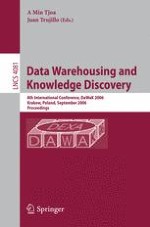For more than a decade, data warehousing together with knowledge discovery technology have made up the key technology for the decision-making process in companies. Since 1999, due to the relevant role of these technologies in academia and industry, the Data Warehousing and Knowledge Discovery (DaWaK) conference series has become an international forum for both practitioners and researchers to share their findings, publish their relevant results and debate in depth research issues and experiences on data warehousing and knowledge discovery systems and applications. th The 8 International Conference on Data Warehousing and Knowledge Discovery (DaWaK 2006) continued the series of successful conferences dedicated to these topics. In this edition, DaWaK aimed at providing the right and logical balance between data warehousing and knowledge discovery. In data warehousing the papers cover different research problems, such as advanced techniques in OLAP visuali- tion and multidimensional modelling, innovation of ETL processes and integration problems, materialized view optimization, very large data warehouse processing, data warehouses and data mining applications integration, data warehousing for real-life applications, e. g. , medical applications and spatial applications. In data mining and knowledge discovery, papers are focused on a variety of topics from data streams analysis and mining, ontology-based mining techniques, mining frequent item sets, clustering, association and classification, patterns and so on. These proceedings contain the technical papers which were selected for presentation at the conference. We received 198 abstracts, and finally received 146 papers from 36 countries.
